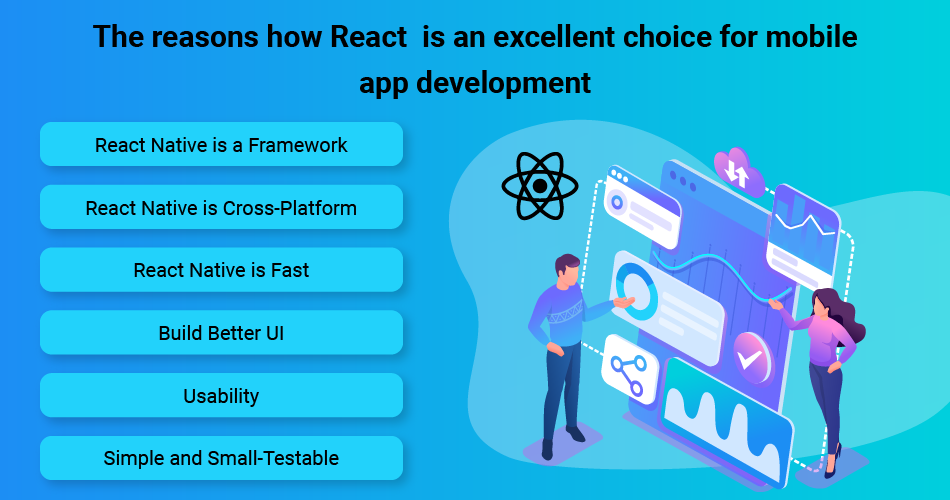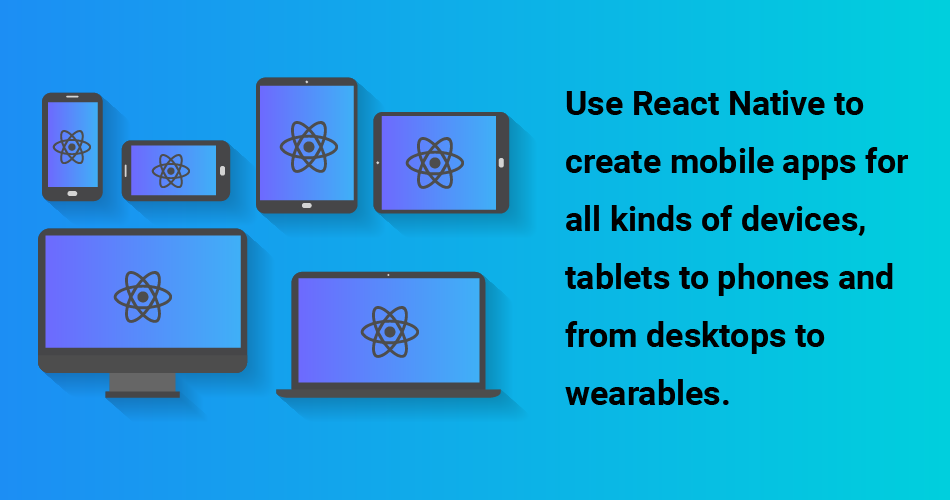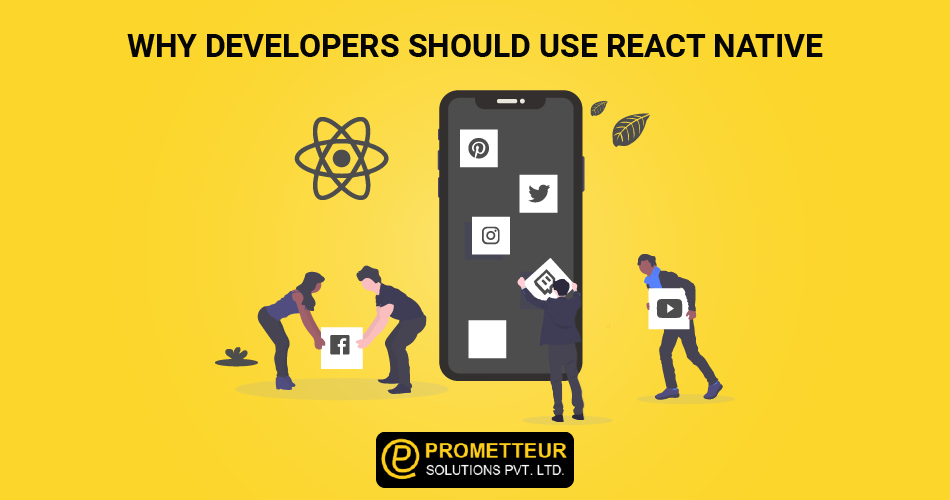The number of different mobile apps that have been developed has skyrocketed, but it’s difficult to make a selection of that flawless mobile app with an excellent user experience. React Native will take your app to a whole new level.
With React Native, you can develop a quality app in a fraction of the time and with a fraction of the budget that it would take otherwise – which means no more worrying about whether or not people will download your app.
HOW REACT NATIVE CAN TRANSFORM YOUR NEXT STARTUP
React Native is a framework for building native mobile apps using JavaScript. It uses the same design as React, but instead of rendering the app on the web, it renders it directly on the phone’s screen. This makes React Native apps feel more natural and less limiting than many other cross-platform solutions.
One of the advantages that come with React is that it has a huge community already, so there are always people to help out if problems emerge. And because everything is written in JavaScript, you don’t have to learn another language or worry about coding conventions that are different from Java or Objective-C – which lets you focus more on your app’s functionality.
This article discusses
How React is an excellent choice for mobile app development.
Here are the top reasons.

React Native is a Framework
Mobile development takes quite a bit of investment upfront. But with React, you don’t need to have a full stack developer team, but can rather have two to three people, each focusing on a specific aspect of your mobile development. If you’re the co-founder of a startup, this may not be an option. But if you’re a developer with a relatively small team of developers, this would be excellent for you.
If your application has a rather simple design, you can still make it look great. It has a built-in custom UI library that allows you to apply a set of styles that mimic iOS and Android’s design patterns. The developers have even promised that they will release other UI libraries in the future.
React Native is Cross-Platform
It is truly cross-platform. It works with iOS and Android, giving developers a choice to target either or both operating system devices. In this sense, it can be compared to JavaScript Native Client, which is designed for use in platforms that don’t support JS.
While React Native works with any modern web app, and there is a library for it, using the underlying SDKs is one of the fastest and most efficient ways to get a native experience for your app.
React is Deployable on the App Store and Google Play. If you have experience working with web technologies, you’ll be able to create a React Native app in no time.
HOW TO IMPROVE REACT NATIVE PERFORMANCE
React Native Is Fast
With React, you get a fast, easy development experience. The app development toolchain (build and deploy your app) is streamlined. So mobile apps are developed for the real device, not the simulator. With React Native, you get a fast, easy development experience.
The React Native development framework makes it easy to build speed and optimized mobile apps. It’s like using Photoshop for iOS apps. It provides powerful tools to create fast and efficient mobile apps that can help develop game apps, photo editors, social media apps, and so on.
And the extra space you will save will be always useful if you are planning to display a lot of photos, videos, texts, and the like in your apps.
Build Better UI
It uses the JavaScript Virtual DOM model, which allows you to more closely approximate the look and feel of native apps. By using JSX, you can translate the JSX code into an equivalent native component in the view hierarchy. This makes it possible to use almost every feature of a native UI in JavaScript, while still having the benefits of an open platform.
React lets you take advantage of existing native UI components on iOS and Android without the need to rewrite your app from scratch. Instead of coding everything from scratch, you can take advantage of existing APIs that have been optimized to work on mobile devices.
React allows you to create the structure of the app without worrying about the real layout. Most mobile app designs use a sidebar, but you can easily replace it with a drop-down, choose which other UI components to use, and use a native UI widget.
You don’t have to set up the different UI states, event handlers, and login states. Instead, you just need to add some JavaScript files, customize a few screens, and copy-paste the code to be applied to your real app.
Usability
React supports React and JSX, React and ES6, React and ES2015, React and Redux. This means that it is also compatible with JavaScript! So we can use it to develop for browser, mobile, desktop, and game platforms.
This is why React Native is not only popular in the mobile space, but also in the webspace: with React Native, developers can write the same code for mobile and the web. That means that we can reuse most of our existing development experience for the web, and also have access to a complete Android/iOS API for creating complex apps.
Simple and Small-Testable
Because the project is completely React-based, you can write single-view tests, mobile-style testing, component tests, and native tests. It is also very friendly to testing and has excellent tools to help you out!
React Native Doesn’t Require Any Complex Project Management Work
It’s like a natural extension of React. Developers using React already have an understanding of how React can work best and that’s why it’s not necessary to manage a project with separate layers. In this case, you can go for one single command to build an app using React.

Also, it is built on compatibility so you can use it today to create mobile apps for all kinds of devices, from tablets to phones and from desktops to wearables.
Streamlined Web Page to App Migration
With React Native, you can start to see the benefits of code reuse in the application by moving parts of the app from the web to the phone. Many developers use the model first approach and then translate the backend code to the native API. However, doing this takes extra time and adds extra complexity to the app.
You can easily apply this React-based workflow to native apps, and then add React elements as you need them. This saves you both time and development costs. In addition, if your app is ported from one language to another, the app should still perform as well as if it was written in that language. React Native gives you that peace of mind.
Easier Mapping From Web To Native APIs
One of the main advantages of React is the ability to develop apps without setting up a full UI in a real-world simulator. This gives you a huge amount of freedom when developing your app.
React Native is Easy to Learn
If you have been following mobile development trends for a while, React Native shouldn’t be too difficult or new to you. You can learn React Native by picking up a few books or tutorials and starting to build your first apps.
Reviews show that React Native is a good start for development. You don’t need to know JavaScript to start building apps with React Native. It is so easy to learn that you could learn other mobile development technologies (including native mobile apps) before you come back to React Native.
Therefore, having React Native as a part of your codebase makes life simpler for everyone involved. Developers can learn React quickly and easily, which will improve their productivity and engagement. And now that React Native runs on many more platforms than React itself, it is accessible to many more developers.
React Native is an Enterprise Solution for JavaScript Developers
React Native is built with enterprises in mind. This makes it an attractive solution for people who need high-performance cross-platform mobile development. It has a specific set of libraries that you’ll need to use for building an excellent React Native mobile app. The most popular libraries are Redux and React. However, other libraries are also available, such as Cycle.js, MobX, and PouchDB.
You Can Take Your Product to the Market Faster
Because React Native can be deployed faster, your customers can enjoy the app’s features sooner. Also, with React Native, you do not have to take an app and port it from another platform, and you can reuse much of the code.
You Can Easily Use Multiple React Elements
In React, you don’t have to choose between creating a web app that looks native and an app that feels native. By using React Native, you can create a native app that looks native and functions natively.
It is an increasingly popular cross-platform solution that leverages web technologies to build native mobile apps. Because React Native is great to use, you have a good chance of having success with React Native mobile app dev.
React Native Works with JavaScript
If you are not yet convinced to try out React Native, here is another good reason to do so: its excellent compatibility with JavaScript. React Native works with modern browsers like Chrome, Safari, and Firefox and supports many popular JavaScript frameworks. This allows you to develop any kind of UI for your app regardless of the technology stack.
Also, you don’t need to worry about which JavaScript framework you should use. This is a lot of configuration and environment management.
React Native uses Apple’s Native Script technology to perform mobile app development most efficiently. All your data should be stored in the user’s native format so that you don’t need to worry about the technical details of the data transport.
React Native Avoids Fragmentation
By re-using core React components, React Native apps tend to be less susceptible to fragmentation. The platform already has an established user base, and new components can already be built with the React Native source code.
React Native is One Larger Framework As you might have guessed by now, React Native takes a bit of setup to get set up. You need to compile your own JavaScript, add React as an additional build step, and set up the project structure.
On the other hand, with an app developed with React, you could run a single command and it would render a solid experience. React Native is Faster After spending a bit of time looking at React Native, you might notice a significant speed difference when comparing native and hybrid projects.
Conclusion
These are our top reasons for choosing React Native for excellent mobile app development. Note that these are the reasons we chose React Native, which you may not have. Feel free to adapt these to your needs.




